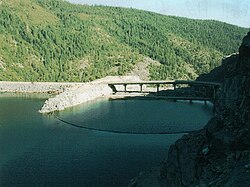Hell Hole Reservoir
| Hell Hole Reservoir | |
|---|---|
 |
|
| Location | Placer County, California |
| Coordinates | 39°04′48″N 120°23′32″W / 39.08011°N 120.39230°WCoordinates: 39°04′48″N 120°23′32″W / 39.08011°N 120.39230°W |
| Type | reservoir |
| Basin countries | United States |
| Water volume | 208,400 acre⋅ft (257,100,000 m3) |
| Surface elevation | 4,630 ft (1,411 m) |
Hell Hole reservoir is an artificial, crescent-shaped lake in the Sierra Nevada mountain range 10 miles (16 km) west of Lake Tahoe in California. The lake is about 3.5 miles (5.6 km) long when at full capacity.
The lake was created in 1966 with the completion of Lower Hell Hole Dam across the Rubicon River, which is a major tributary of the Middle Fork of the American River. Hell Hole is named for a deep canyon which is now under the waters of the lake.
How the canyon came to be named Hell Hole is a combination of folklore and speculation. An early author, George Wharton James (1858–1923), visited the canyon in 1913. James attributed the name to an unidentified miner seeking riches during the Squaw Valley mining excitement of 1862. It was "a hell of hole to get out of," James wrote but admitted his source for the place name was more speculative than the anonymous miner's chances for riches at Squaw Valley.
James' guide for the 1913 camping expedition to Hell Hole was Bob Watson, a well-known camping guide who operated in the Lake Tahoe Region from the 1880s into the first decades of the 20th century. Watson may have been the source of the story who sought to entertain and edify his paying clients with tales of local history. James attributed much of the local lore to Watson.
The United States Board on Geographic Names attributes the first use of the name "Hell Hole" to a United States Geological Survey map of 1894. The board was created in 1890, so previous uses of the name on federal government maps are possible.
James reported finding a natural lake near the Hell Hole chasm known as Bear Lake, which would have been drowned by the reservoir. James also described Hell Hole in terms that belies the colorful name: "Hell Hole? Then give me more of it," he wrote. The author reported his pleasure of the canyon was derived from its rugged nature that precluded human exploitation: Logging, mining, water development and road building, evident in other portions of the Lake Tahoe region. It was "a paradise of delightful surprises," he wrote.
Lower Hell Hole Dam (its official name) is operated by the Placer County Water Agency, a powerful political force in the region. The agency controls two dams in the Eldorado National Forest and Tahoe National Forest. The water agency gained its power from financing approved by Placer County voters in 1961.
...
Wikipedia
